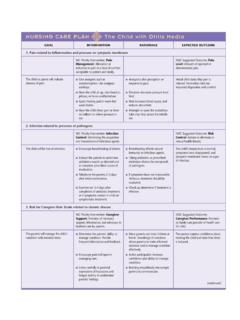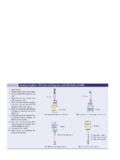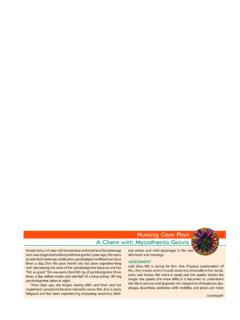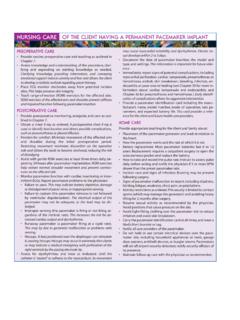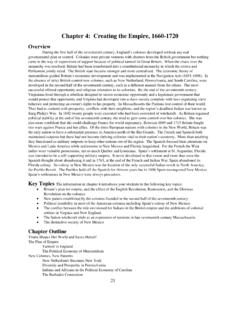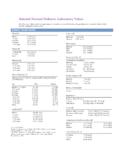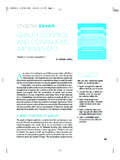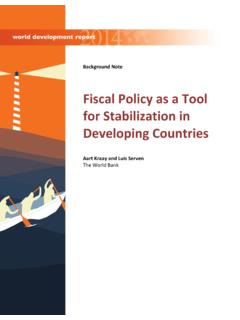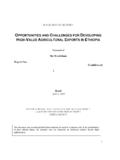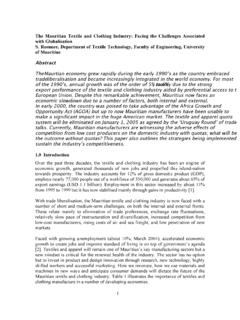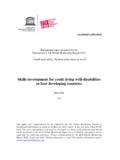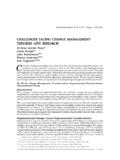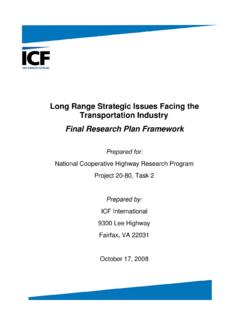Transcription of Challenges Facing the Developing Countries
1 Chapter36W 3/24/04 1:46 PM Page 1. CHAPTER 36W. Challenges Facing the Developing Countries L LEARNING OBJECTIVES. 1 Describe the extent of world income inequality. 2 Explain some of the main Challenges Facing Developing Countries . 3 Define the view of development known as the Washington Consensus.. 4 Outline the current debates about development policies. In the comfortable urban life of today's developed Countries , most people have lost sight of the fact that a short time ago very short in terms of the life span of the earth peo- ple were nomadic food gatherers, garnering an existence as best they could from what nature threw their way. It has been only about 10 000 years since the Neolithic Agricultural Revolution, when people changed from food gatherers to food producers. Throughout most of subsequent human history, civilizations have been based on a com- fortable life for a privileged minority and unremitting toil for the vast majority.
2 Only within the past two centuries have ordinary people become able to expect leisure and high consumption standards, and then only in the world's economically developed Countries . In this web-based chapter we review some of the Challenges faced by the world's Developing Countries those Countries that have not yet been fortunate enough to achieve the living standards that we, in Canada, all too often take for granted. The Uneven Pattern of Development developed Countries The higher-income Countries of the world, Over 6 billion people are alive today, but the wealthy parts of the world contain no including the United States, Canada, Western Europe, more than 20 percent of the world's population. Many of the rest struggle for subsistence. Japan, Australia, and Many exist on a level at or below that endured by peasants in ancient Egypt or Babylon.
3 South Africa. The richest Countries with the highest per capita incomes are referred to by the Developing Countries United Nations as developed Countries . These include the United States, Canada, most The lower-income Countries of the world, most of of the Countries of Western Europe, South Africa, Australia, New Zealand, Japan, and which are in Africa, Asia, a few others. The poorer states are referred to by the UN as the Developing Countries and and Latin America. include a diverse set of nations. Some, such as Vietnam, Argentina, and China, are grow- newly industrialized ing very rapidly, while others, such as Haiti, Rwanda, and Sierra Leone are actually Countries (NICs). Countries that have experiencing negative growth rates of real per capita income. Between these two is industrialized and grown another group of nations, called the newly industrialized Countries (NICs).
4 They include rapidly over the past 40. South Korea, Singapore, Taiwan, and Hong Kong. These Countries grew rapidly in the years. 2005 Pearson Education Canada Inc. Chapter36W 3/24/04 1:46 PM Page 2. 2 Chapter 36W Challenges Facing the Developing Countries four decades after 1960 and typically have per capita incomes close to 50 percent of those found in the developed nations. Several other Countries in Southeast Asia are close behind the NICs. These include Indonesia, Malaysia, and Thailand. Viewing the problem of raising per capita income in a poorer country as one of eco- nomic development recognizes that the whole structure of its economy often needs to be altered to create economic growth. This is a complex task; many Countries remain unde- veloped today despite decades of effort by their governments (often assisted with aid from developed Countries ) to get them on a path of sustained growth.
5 Data on per capita incomes throughout the world (as shown in Table 1) cannot be accurate down to the last $100 because there are many problems in comparing national incomes across Countries . For example, homegrown food is vitally important to living standards in Developing Countries , but it is excluded from or at best imperfectly included in the national income statistics of most Countries . Nevertheless, the data reflect enormous real differences in living standards that no statistical inaccuracies can hide. The development gap the discrepancy between the standards of living in Countries at either end of the distribution is real and large. Figure 1 provides another way of looking at inequality. It shows the geographical dis- tribution of per capita income. The map reveals why modern political discussions of global income distribution often use the labels North and South to refer to the rich and the poor nations, respectively.
6 The consequences of low income levels can be severe. In rich Countries like Canada and the United States, variations in rainfall are reflected in farm output and farm income. In poor Countries , variations in rainfall are often reflected in the death rate. In The North South Institute is a Canadian research institute that these Countries , many people live so close to a subsistence level that slight fluctuations focuses on economic development. in the food supply bring death by starvation to large numbers. Other, less dramatic See its website: characteristics of poverty include inadequate diet, poor health, short life expectancy, and illiteracy. For these reasons, reformers in Developing Countries feel a sense of urgency not felt by their counterparts in rich Countries . Yet, as Table 2 shows, some of the poorest Countries in the world are among those with very low or negative growth rates of per capita GDP, with the following consequence: The development gap has been widening for the very poorest Countries .
7 TABLE 1 Income and Population Differences Among Groups of Countries , 2000. (1) (2) (3) (4) (5) (6). GNP Per Capita Number of GNP Population GNP Per Capita Percentage Percentage of (US$) Countries (US$ billions) (millions) (US$) of World Population World GNP. Less than $755 63 997 2 460 410 $756 to $2995 54 2 324 2 048 1 130 $2996 to $9265 38 3 001 647 4 640 $9266 or more 52 24 994 903 27 690 World 207 31 315 6 057 There is considerable inequality in the distribution of world income. The unequal distribution of world income is shown in columns 5 and 6. The poorest three-quarters of the world's population earns just over 10 percent of world income. The richest 15 percent earns almost 80 percent of world income. (Source: World Bank Atlas, 2002. International Bank for Reconstruction and Development/The World Bank.). 2005 Pearson Education Canada Inc.
8 Chapter36W 3/24/04 1:46 PM Page 3. Chapter 36W Challenges Facing the Developing Countries 3. FIGURE 1 Countries of the World, Classified by Per Capita GNP, 2000. Income group dollars Low Lower-middle Upper-middle High $755 or less $756 $2995 $2996 $9265 $9266 or more There is a sharp geographical division between North and South in the level of income per capita. The nations of the world are classified here according to four levels of measured per capita GNP, as shown in Table 1. The poorest group, shown in brown, represents 40 percent of the world's population and just over 3 percent of world GNP. The wealthi- est group, shown in orange, includes North America, Europe, Japan, and Australia and represents 15 percent of the world's population and almost 80 percent of world GNP. TABLE 2 The Relationship Between the Level and the Growth Rate of Per Capita Income, 1990 2000.
9 Growth of GNP GNP Population GNP Per Capita Per Capita, 1990 1996 Number of (US$ billion) (millions) (US$). (% per year) Countries 2000 2000 2000. Less than 0 53 943 752 1 250. 0 to 17 496 166 2 980. to 41 12 578 1 122 11 210. to 31 13 550 975 13 890. or more 36 3 618 2 933 1 230. The very poorest Countries spend much of their increase in income on a rising population. Hence, their increase in income per capita is less than half that of the Countries that are already richer. The gap in income between rich and many of the very poor Countries is not closing. (Source: World Bank Atlas, 2002. International Bank for Reconstruction and Development/The World Bank.). 2005 Pearson Education Canada Inc. Chapter36W 3/24/04 1:46 PM Page 4. 4 Chapter 36W Challenges Facing the Developing Countries As we shall see, this is a problem of both output and population.
10 It is also an international political problem. What are the causes of underdevelopment, and how may they be overcome? Impediments to Economic Development Per capita income grows when aggregate income grows faster than population. Many forces can impede such growth. Here we examine a number of possible impediments. Resources A country's supply of natural resources is important. A country with infertile land and inadequate supplies of natural resources will find income growth more difficult to achieve than one that is richly endowed with such resources. How these resources are managed also matters. When farmland is divided into many small parcels, it may be much more difficult to achieve the advantages of modern agricultural techniques than when the land is available in huge tracts for large-scale farming. Fragmented land holdings may result from a dowry or inheritance system or may be politically imposed.

